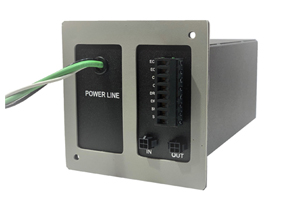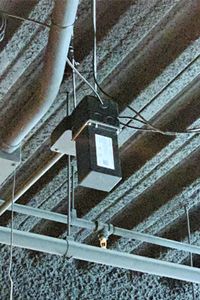In the event of an emergency, such as power outage, PoE power source failure or disconnection of cabling, the CoreSync Emergency Lighting Bypass (ELB) will divert around normal PoE control and activate the emergency power source and onboard LED driver. The fixture will be powered to full brightness irrespective of previous state/control. Once the emergency condition is cleared, the lighting system will resume normal operation and the fixture will revert to the previous CoreSync control state. The ELB also provides inputs for testing and fire alarm connection.
Emergency lighting
National life safety and building codes require regular testing for emergency lighting systems. Emergency lighting systems shall be tested in accordance with one of 4 options.
- Functional Testing: The emergency lights are operated and tested monthly for at least 30 seconds, ideally using a manual test button. The emergency lights also need to be operated on an annual basis for a minimum of 90 minutes for battery applications.
- Self-Testing: The units can test themselves and raise an issue via an indicator light. A visual inspection should be conducted every 30 days to make sure they are not damaged and that no indicator lights are on.
- Computer-Based Testing: Using battery operated emergency lighting equipment, then any issues with the lights encountered during self-testing will be reported and logged via a computer. Annual test shall be performed for a minimum of 1-1/2 hours. The computer system shall be capable of providing reports and history of tests and failures at all times.
- Emergency Equipment Testing: Emergency generators and transfer switch equipment serving emergency lighting systems shall be bested. In the USA they are tested per NFPA 110, while stored electrical energy systems are tested per NFPA 111.
Emergency lighting will activate upon failure of the power source, or when an emergency operation is activated , such as a fire alarm or test scenario.
US building and life safety codes call for a minimum of 90 minutes of egress lighting. Some jurisdictions or fire departments may require longer, it’s advisable to check with the local entities.
What type of power source is used during an emergency? An emergency power source can be a central battery inverter, a generator, or an approved alternate utility. Another option is self-contained battery units which power a light source and incorporate a battery, battery charger and bypass device.
Depending on the occupancy type and use of the building, we can distinguish three emergency lighting types
- Egress lighting: allows recognition of the evacuation routes. It provides lighting not less than an average of 1 ft-candle (10.8 Lux) at the floor level.
- Stair lighting: minimum illumination for stars shall be at least 10 ft-candle (108 lux) measured at the walking surfaces.
- Assembly lighting: minimum illumination of walking surface and exit access shall be 0.2 ft-candle (2.2 lux) during performances. Required illumination shall be automatically restored upon activation of the fire alarm system.
Advantages
- Can be installed without the need for a dedicated emergency electrical system.
- They are easy to wire so that they operate when the local lighting fails.
- Simple wiring that uses local circuits, the device operates if the local circuit fails.
- Systems can easily be extended by installing additional units.
- The failure of one unit will not render the others inoperative.
Disadvantages
- Non-maintained lights require operation of each final circuit to perform the monthly test.
- Some units have a short battery life. Battery life is often limited to between 3 and 5 years, dependent on the application
- Battery replacement is costly and time consuming.
- Environmental conditions may vary across the system, and batteries may be affected by relatively high or low temperatures
- Maintenance testing and observation of each individual unit is required and labor intensive.
Advantages
- Better system control and monitoring as the maintained circuits can be locally or remotely switched.
- They allow a wide choice of light fixtures, similar to what you would see on the normal lighting system.
- Real-time status of the power system can be monitored easily and automatically.
- The life of the battery is between 5 and 25 years, dependent on type.
- The lights can operate at their allowable ambient temperatures, low temperatures only need to be maintained at the battery location.
Disadvantages
- A dedicated service technician is usually required to design, install and maintain the inverter and battery equipment.
- Each light or sub circuit must include devices to monitor the local lighting supply in the areas requiring emergency lighting unless operated in maintenance mode.
- Future capacity needs to be accommodated in the initial design to avoid costly additions.
- The emergency distribution equipment and cabling is required to be fire protected and separate from normal distribution equipment.
- Higher initial capital equipment costs.
PoE and LED
LED lamps typically have a 50,000h rated life, ten times that of a typical fluorescent tube. Using LED emergency luminaires will greatly reduce the maintenance costs of an emergency lighting system and they have a longer expected life and lower running costs than standard luminaires.
PoE lighting refers to the ability to use an Ethernet cable to power light fixtures (luminaires) and transmit data between the luminaire and the control software. PoE installation is normally more cost effective than traditional electrical work, plus operating costs are lower over its lifetime and data can inform further decisions to save costs. All without impacting the light quality for occupants
The management of PoE is subject IEEE 802.3af/at/bt standards to ensure PoE technology is safe. PoE injectors and switches will not damage any equipment, even if the equipment is not designed for PoE applications. PoE blog
In addition to the PoE standards, such as IEEE 802.3bt Type 4 Class 8 (90W), you also need to look at the standards that impact cabling systems. It is critical to ensure your cabling design and implementation complies with both. Read more>>
Lights in a networked system become a list of individual components with an IP address. The main challenge with PoE emergency lighting has been providing emergency power and control to individual PoE fixtures. This is because emergency power cannot be provided through a network switch due to limitations with UL and life safety code. With the ELB you can control emergency lighting with you normal power and switch equipment, and back up the lighting through the emergency AC system.
Electrical conduit and cabling is not required since since Class 2 cabling is used. This allows for IT staff to install low voltage cabling for the lighting in lieu of an electrician for most applications.
PoE installations also offer flexibility unlike ceiling based AC outlets. A networked cable can be changed from a light to a camera at any time. And can be moved around easily using in-house staff.
Product Highlights
- CoreSync enabled – Low voltage PoE infrastructure for power, control, communication.
- Easy Mounting – Allows mounting on standard 4×4 junction box.
- Standard BUS input and output and can be installed in daisy-chain with any other CoreSync devices.
- Available in a range of power outputs – Provides flexibility across a wide variety of fixture types.
- Powered by building emergency source – High reliability; no local batteries required; reduced maintenance.
- No auxiliary PoE port needed – Optimized and cost effective PoE infrastructure utilization.
- UL 924, CSA C22.2 No 141, FCC Class A – Meets agency standards for safe operation and reliability.
- NFPA (NEC, Life Safety Code) IBC – Compliant with important building safety requirements.
- Class 2 device.
- Provides a dry contact that can connect to inputs such as a fire alarm, that can switch the ELB to full brightness.
- 90W support – Offering architects greater flexibility on their light design.
- Supports both single color and tuneable-white light.
- Supports white-tuning and intensity control for Human Centric Lighting (HCL) or Circadian Lighting schemes.
- A number of different lights can be designated as emergency lights.
- Provides a range of power/current outputs to serve a variety of different light fixture types.
For more information on the CoreSync Emergency Lighting Bypass, download our datasheet.
Learn more and read the CoreSync brochure.
Identify additional products in the CoreSync portfolio, download our catalog.
A real customer using intelligent CoreSync technology, Georgia-Pacific.
The CoreSync EcoSystem Alliance brings together a range of companies to provide network connected services in commercial buildings and everyday life. Learn More
Other products
The CoreSync Gateway 60W is a low voltage power distribution and network connected module compliant with the IEEE 802.3at standard and Cisco’s UPOE standard that utilizes 60W-per-port PoE technology. This Gateway 60W receives a minimum guaranteed 51 watts of usable...
The CoreSync Compact High Current Driver is a compact low voltage, DC/DC LED driver that can be programmed to specific power outputs, for driving LED engines in a wide variety of light fixtures. Controlled and powered by a CoreSync Gateway....
The CoreSync Advanced Lighting Sensor is a low voltage sensor platform leveraging network connected Molex CoreSync infrastructure for digital building applications. Occupancy and ambient light data can be granularly collected by Molex sensor array for advanced lighting control. Data can...
EnOcean Occupancy Sensors, Ceiling Mount are wireless and self-powered, providing a cost-effective way to control energy use in unoccupied rooms. The EnOcean Occupancy Sensors, Ceiling Mount, harvest solar energy from indoor light and use radio frequency technology to communicate wirelessly...
The EnOcean Temperature/Humidity Sensor is a maintenance free wireless device that regularly measures and reports the temperature and humidity in a space. The Sensor is powered by a solar cell and features on-board energy storage that allows operation for days...
The Advanced Environmental Sensor is a low voltage sensor platform leveraging network connected Molex CoreSync infrastructure for digital building applications. VOCs (volatile organic compounds), temperature, and humidity data granularly collected by Molex sensor array can be transferred to BMS and/or...
Get in touch with us
Leave your information below and we'll have a sales representative contact you.




